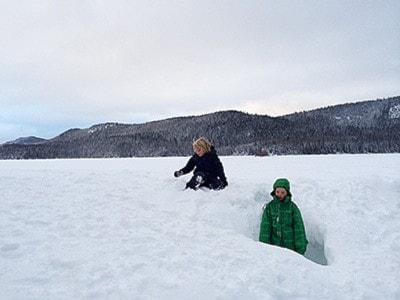Wet ice conditions kept many residents and their guests from enjoying their usual activities on Lac des Roches throughout the holiday season.
Although the ice depth measures between six and eight inches – plenty deep enough for foot and vehicle use – mild temperatures and heavy snow contributed to the accumulation of deep overflow water and slush on top of the ice.
Since snowmobilers count on frozen lakes in the South Cariboo to access miles of trails, they proceeded to use the lake and made their usual paths around and across the lake, often shooting up giant rooster tails of water or displacing huge sheets of slightly frozen slush.
Colder nights since early January have resulted in solidifying much of the mush on the lake resulting in miles of ruts and ridges criss-crossing the lake. The lake is now an extremely bumpy ride for sledders and the frozen obstacle course will provide a challenge for walkers and skiers for the remainder of the winter.
Other than on manicured ice rinks in front of several cabins, skaters in particular will be challenged to find patches of smooth ice among the ice’s cracks and tracks. Ice fishers, particularly those intent on catching burbot, have begun night fishing on some of the nearby shoals, which attract these unique and tasty fish during the winter spawning season.
Bird watching
Lac des Roches birding enthusiast, Wendy Marshall reports the annual local Christmas bird count showed the “numbers of species as well as numbers within each species were a little lower than previous years.”
The event included a one-day count along a predetermined route by a group of birders and stationary feeder counts over a short period of time. On Jan. 4, eight members of the Bridge Lake Naturalist Club logged dozens of species during their day-long excursion.
A significant surprise mentioned by Wendy was the first time presence of many dark-eyed juncos, which should have flown south before winter. She explained they are ground feeders and usually migrate to lower elevations and climates where snow does not cover the seeds on the ground.
While juncos may be getting some of their nutrition on the ground below yard feeders, something may have changed in our ecosystem, which allows them to stay in our area.
Winter finches have not yet appeared and Wendy speculates the redpolls and pine grosbeak have found a good food supply to the north, which would explain their absence.
Snowy playground
Sledders report there is plenty of snow to enjoy the trails and cut blocks on the usual local trails.
Active log hauling is still underway and caution must be exercised on all forestry roads. The logging activity has resulted in new forestry roads, which appeal to sledders constantly looking for connecting routes to enhance their trail rides.
Several neighbours have commented they appreciate the ledge created on the forestry roads by the grader operator, using his wing blade, to create a safe riding lane for their sleds, out of the path of regular road traffic.
Critter watch
There are only a few reports of actual animal sightings, but the frequent snowfall has provided repetitive evidence of plenty of wildlife activity throughout the neighbourhood and surrounding Crown land.
Moose, deer, coyote, otter, rabbit and ermine tracks are common and reappear soon after each snowfall.
Although the howls of several wolves seemed to originate from locations along the south edge of the big lake, no obvious tracks were seen, so presumably they are keeping out of sight in the heavily wooded shoreline.
